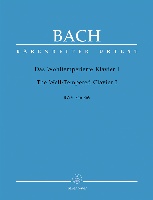O heilges Geist- und Wasserbad (O bath of Holy Spirit
and of water), BWV 165, is a church cantata by Johann
Sebastian Bach. On 2 March 1714 Bach was appointed
concertmaster of the Weimar court capelle of the
co-reigning dukes Wilhelm Ernst and Ernst August of
Saxe-Weimar. As concertmaster, he assumed the principal
responsibility for composing new works, specifically
cantatas for the Schlosskirche (court church), on a
monthly schedule. He composed this cantata for Trinity
Sunday. The prescribed r...(+)
O heilges Geist- und Wasserbad (O bath of Holy Spirit
and of water), BWV 165, is a church cantata by Johann
Sebastian Bach. On 2 March 1714 Bach was appointed
concertmaster of the Weimar court capelle of the
co-reigning dukes Wilhelm Ernst and Ernst August of
Saxe-Weimar. As concertmaster, he assumed the principal
responsibility for composing new works, specifically
cantatas for the Schlosskirche (court church), on a
monthly schedule. He composed this cantata for Trinity
Sunday. The prescribed readings for the Sunday were
from the Epistle to the Romans, reflecting "depth of
wisdom" (Romans 11:33--36), and from the Gospel of
John, the meeting of Jesus and Nicodemus (John
3:1--15).
The cantata text was written by court poet Salomon
Franck and published in Evangelisches Andachts-Opffer
in 1715. The poet follows the gospel closely. The
opening refers to Jesus saying "Except a man be born of
water and of the Spirit, he cannot enter into the
kingdom of God". The text reflects in a recitative as
movement 2 upon birth in the Spirit as baptism through
God's grace: "Er wird im Geist und Wasserbade ein Kind
der Seligkeit und Gnade" (In the bath of spirit and
water he becomes a child of blessedness and grace).
Movement 3, an aria, considers that the bond has to be
renewed throughout life, because it will be broken by
man (movement 4). The last aria is a prayer for the
insight that the death of Jesus brought salvation,
termed "Todes Tod" (death's death). The cantata is
concluded by the fifth stanza of Ludwig Heimbold's Nun
lasst uns Gott dem Herren, mentioning scripture,
baptism and the Eucharist.
Bach likely first performed the cantata on 16 June 1715
and performed it again in his first year in Leipzig,
reviving it there on Trinity Sunday, 4 June 1724, with
presumably minor changes. However it is only through a
copy prepared by Bach's assistant Johann Christian
Köpping for the latter performance that the work is
known today.
In the first aria, the ritornello is a fugue, whereas
in the five vocal sections the soprano and violin I are
a duo in imitation on the same material. These sections
are composed in symmetry, A B C B' A'. The theme of B
is the reverse of that of A, that of C is derived from
measure 2 of the ritornello. Alfred Dürr relates the
form to the birth mentioned in the gospel. The first
recitative is secco, but several phrases are close to
an arioso. The second aria, accompanied by the
continuo, is dominated by an expressive motif with
several upward leaps of sixths, which is introduced in
the ritornello and picked up by the voice in four
sections. The second recitative is accompanied by the
strings and intensifies the text by several melismas,
"adagio" marking on the words "hochheiliges Gotteslamm"
(most holy Lamb of God), and melodic parts of the
instruments. The last aria, mentioning the snake, is
described by Whittaker: "the whole of the obbligato for
violins in unison is constructed out of the image of
the bending, writhing, twisting reptile, usually a
symbol of horror, but in Bach's musical speech a thing
of pellucid beauty". The cantata is closed by a
four-part setting of the chorale.
Although originally scored like chamber music for four
vocal soloists (soprano, alto, tenor and bass), a
four-part choir in the closing chorale, bassoon, two
violins, viola, and basso continuo, I created this
arrangement for Solo Concert (Pedal) Harp.





 Faire un don
Faire un don